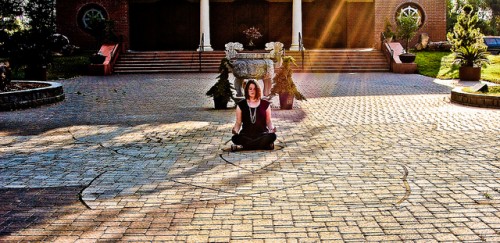Radical.
We might associate the word with the neon-clad surf and skateboarding culture of the 1980’s, or the flower powered love children of the 1960’s or perhaps we think of the eco-political activism inspired by the work of Edward Abbey.
Maybe it brings to mind more extreme examples of anarchy and terrorism.
Whether it means catching rad air or working on a radical environmental policy campaign, the common thread is that it is likely taking place on the fringes of society. Radical is cutting edge. It is shocking. It is dangerous. Radical, by definition, is not popular.
Yoga, on the other hand, is the band geek turned prom queen.
Growing up in the suburban Midwest, I spent 18 years imagining that the whole country, if not the entire western world, looked exactly like it did in my Irish-Italian-Catholic community. Aside from Chinese take-out, the culture and philosophy of the East simply had no place. If it did manifest in some form or another it was certainly a radical
thing.
Now, I can find a yoga studio in every neighboring town. My mom just tried her first Yoga class. I recently heard a woman reference something called Jesus Yoga. Marketers have started latching on to the trend. You can go to a juice bar for a Yogi smoothie or head to the spa for a Yoga facial (bonus, because it involves coffee). You can even purchase a Yoga laptop. Why not? Treat. Yo. Self.
In lieu of this newfound popularity, Yoga seems undeserving of any radical labels. As the Dude’s good friend Walter once said, am I wrong?
Jokes and pathetic marketing ploys aside, Yoga is a booming industry.
It’s considered one of the fasted growing sectors of the Outdoor and Specialty retail markets. They say it’s a good time to be in the business of Yoga. That’s Yoga, with a capital Y. Packaging and selling Yoga can and does lead to people making healthier decisions, which is great. Yoga is universal. It belongs to everyone. There is no copyright on the name. Just as a brand is only an idea, an archetype, something separate from the actual product that it represents, Yoga is something distinct from the actual goods.
Unlike a brand, however, the actual product cannot be bought. Or sold. What are those actual goods? What exactly does the Yoga that we sell claim to represent? Well, let’s call it yoga. The product that Yoga purports to sell is yoga.
Except yoga is not a product at all.
The word product necessitates an end result. To me, yoga is all about a process, and in it there will always be room to go deeper, to evolve further. There are many by-products along the way but there is no end result. It is a continually refining state of being. To go beyond the idea of Yoga and find ourselves in a state of yoga involves a very radical act of disobedience: letting go of our attachment to the idea that any action is only worth the results that it produces.
To find this state requires that we set aside everything on our to-do list. It requires us to step away from all ambition. It teaches us to see the inherent value in every person, place, thing, and circumstance we encounter and to see that value not simply as the net sum of various positive and negative aspects, but rather as the full spectrum of characteristics that exist in relation to that object.
It teaches us to love all the parts of ourselves that society deems inappropriate, or disgusting, or dangerous, as equally as the parts that society encourages. To do so is to overcome the power of our consumption-frenzied culture. The advertisements team up with our own misunderstandings from within to take advantage of our tendency to label everything as good or bad, one or the other. They tell us, buy this to avoid that bad thing, or go here to find that good thing.
It is not only a matter of how we spend our money but rather how we live our lives. By seeing through the veil of good/bad or beginning/end, we regain the control to think and act for ourselves. When we see things as the infinitely complex combinations of good and bad that they truly are, we can bypass the impulsive, emotional responses that the system is counting on. This, by all accounts, constitutes some very radical behavior.
To follow the means of yoga then is to turn away from all the things that a lifetime of conditioning has taught us that we need to do or need to be. It is to disobey our family, our teachers, our friends and our lovers. It is to disobey the advertisements trying to convince us that the next purchase will bring happiness. It means disobeying the wisdom that comes from anywhere but within.
Because everything we need is already inside, it’s only a matter of digging deep enough to find what we are looking for and learning to trust what we find.
When we free ourselves from judgment and learn to see the world from a place of love, we open up enough to truly connect with the wisdom of others. Then, we can freely decide to accept or reject that wisdom. In accepting, it becomes our own.
First though, we must find the courage to trust ourselves. To do this, we will need to take risks. We will make mistakes. We will at times go against the better judgment of those who love us most. We will need to learn for ourselves. Respectfully, we will need to suspend any regard for all of the rules we have been taught to obey and accept the risks of drowning in our folly.
The definition of radical is that which is very different from the usual or traditional; extreme.
A lesser known definition of the word is that which is of, or relating to, the origin; relating to the roots. To practice yoga is to embody both definitions. Finding yoga means connecting with the origin, or root, of our being and the love that exists there. When we free ourselves from our judgments, both internal and external, this original-root-love is what we find.
Finding this is a difficult and often painful path.
When we are left alone in the stillness that allows us to the opportunity to connect with this root-love, the stillness that yoga guides us toward, our default mode is to seek distractions. We try to fill the void rather than settle into it. The Yoga that we sell in the form of stretchy pants, rubber mats, and spa treatments, has become just another distraction from connecting to this most basic part of our lives.
We are willing to pay for that distraction, which makes it a friend of the machine. It puts money into the system. We can argue for and against the commercialization of Yoga until our heads turn blue. Instead, let us focus on the yoga that we must seek within, which offers no value to the gross national product, and the truly radical nature that it embodies.
In the eyes of consumption frenzied cultures within which we exist, anything that does not involve buying stuff, or working to one day afford more stuff, or constantly moving forward, wherever that might be, is generally considered a waste of time. Rather than constantly moving and looking for the next thing, yoga asks us to find the stillness and happiness in everything we already have.
So, yes, yoga is quite radical. It goes against everything our culture holds sacred. It’s actually a pretty radical waste of time.
Love elephant and want to go steady?
Sign up for our (curated) daily and weekly newsletters!
Author: Eddie Schoen
Editor: Catherine Monkman












Read 0 comments and reply